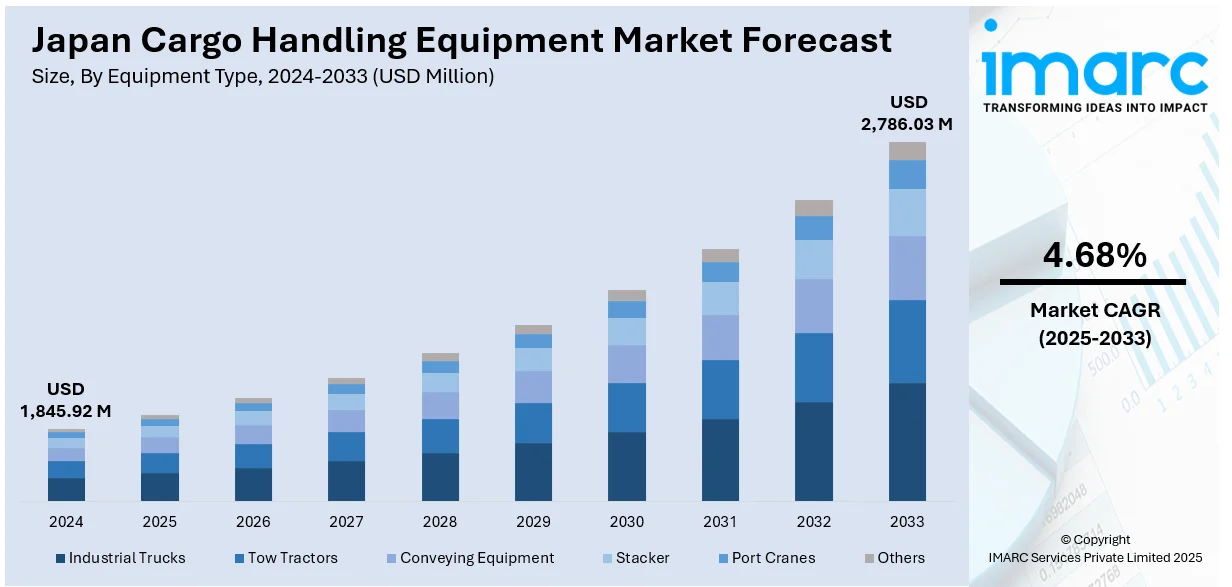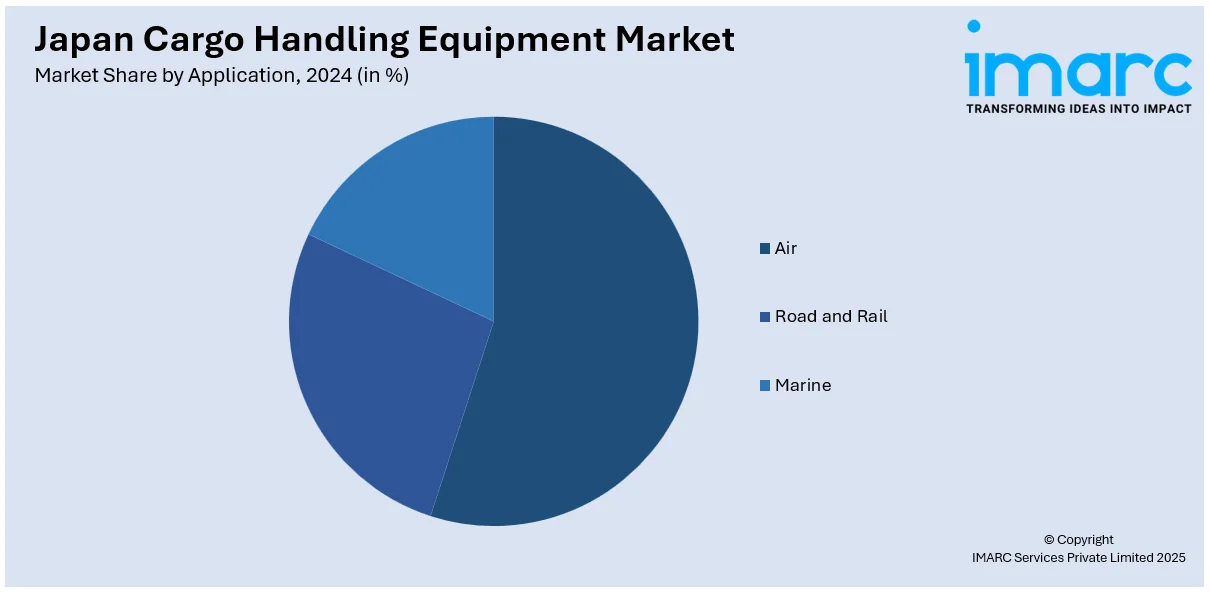
Japan Cargo Handling Equipment Market Size, Share, Trends and Forecast by Equipment Type, Propulsion Type, Application, and Region, 2025-2033
Japan Cargo Handling Equipment Market Overview:
The Japan cargo handling equipment market size reached USD 1,845.92 Million in 2024. Looking forward, IMARC Group expects the market to reach USD 2,786.03 Million by 2033, exhibiting a growth rate (CAGR) of 4.68% during 2025-2033. The increase in demand for cost-effective logistics, Japan's geographical position as a strategic trade hub, advancements in automation and robotics technology, and government infrastructure projects are fueling market growth. Moreover, the push for energy-efficient equipment, labor shortages leading to automation adoption, and expansion of international trade agreements are supporting the market growth. Furthermore, competition pressure on logistics, port operations technologies, and environmental regulations promoting sustainable handling solutions, which is providing impetus to Japan cargo handling equipment market share.
|
Report Attribute
|
Key Statistics
|
|---|---|
|
Base Year
|
2024 |
|
Forecast Years
|
2025-2033
|
|
Historical Years
|
2019-2024
|
| Market Size in 2024 | USD 1,845.92 Million |
| Market Forecast in 2033 | USD 2,786.03 Million |
| Market Growth Rate 2025-2033 | 4.68% |
Japan Cargo Handling Equipment Market Trends:
Increasing Demand for Affordable Logistics and Supply Chain Solutions
Japan's equipment industry for handling cargo is greatly influenced by the increasing requirement for efficient logistics and supply chain management solutions. As a world-leading economy and among the world's most prominent trading nations, Japan is a vital contributor to global logistics. The volumes in trade within the country have been increasing year after year, calling for more rapid, efficient ways of handling the flow of commodities. For instance, Japan's exports in 2023 alone reached over ¥100.88 trillion (USD 680 billion), showcasing the extensive need for high-efficiency cargo handling solutions. This demand is also driven by the rapid increase in trade with other countries, especially those in the Asia-Pacific region. To support this growth, Japanese manufacturers are investing heavily in automated and smart cargo handling systems. Moreover, government initiatives aimed at modernizing port infrastructure are further propelling advancements in this sector.

Strategic Location as a Global Trade Hub
The geographic location of Japan has a significant impact on its cargo handling equipment market. Located in the Asia-Pacific, Japan is a significant hub for goods exchange between North America, Europe, and Asia. The country benefits from proximity to significant shipping routes and has colossal volumes of cargoes, in which high demand is exerted on efficient cargo handling systems. Ports like the Port of Tokyo and Port of Yokohama are major world trade ports, and as such, there is more need for modern cargo handling equipment in a bid to match these high volumes successfully. In 2024, Japan's major ports handled over 1.17 million twenty-foot equivalent units (TEUs) of containerized cargo, highlighting the need for efficient cargo handling solutions in maintaining the smoothness of the operations.
Advancements in Automation and Robotics
Advancements in automation and robotics technology are the major growth drivers for the Japanese cargo handling equipment market. For decades, Japan has led in terms of automation and robotics, and both of these are fast being adopted by the logistics and cargo handling industries. The use of robotic technology, such as automated guided cars (AGVs) and robot arms, enhances warehouse operations and port logistics by reducing the use of human error and increasing the efficiency of operations. A prime example of this is the Port of Kobe's automated cargo handling system that uses robotic cranes and automated vehicles for container transport at high speeds. The Japanese robotics market for its logistics sector is anticipated to grow considerably, which is further favoring the market growth. Automation of cargo handling is reducing labor costs, accelerating, and enhancing safety, which is a key factor driving the Japan cargo handling equipment market growth.
Japan Cargo Handling Equipment Market Segmentation:
IMARC Group provides an analysis of the key trends in each segment of the market, along with forecasts at the country and regional levels for 2025-2033. Our report has categorized the market based on equipment type, propulsion type, and application.
Equipment Type Insights:
- Industrial Trucks
- Tow Tractors
- Conveying Equipment
- Stacker
- Port Cranes
- Others
The report has provided a detailed breakup and analysis of the market based on the equipment type. This includes industrial trucks, tow tractors, conveying equipment, stackers, port cranes, and others.
Propulsion Type Insights:
- IC Engine
- Electric
A detailed breakup and analysis of the market based on the propulsion type have also been provided in the report. This includes IC engine and electric.
Application Insights:

- Air
- Road and Rail
- Marine
The report has provided a detailed breakup and analysis of the market based on the application. This includes air, road and rail, and marine.
Regional Insights:
- Kanto Region
- Kansai/Kinki Region
- Central/Chubu Region
- Kyushu-Okinawa Region
- Tohoku Region
- Chugoku Region
- Hokkaido Region
- Shikoku Region
The report has also provided a comprehensive analysis of all the major regional markets, which include Kanto Region, Kansai/Kinki Region, Central/Chubu Region, Kyushu-Okinawa Region, Tohoku Region, Chugoku Region, Hokkaido Region, and Shikoku Region.
Competitive Landscape:
The market research report has also provided a comprehensive analysis of the competitive landscape. Competitive analysis such as market structure, key player positioning, top winning strategies, competitive dashboard, and company evaluation quadrant has been covered in the report. Also, detailed profiles of all major companies have been provided.
Japan Cargo Handling Equipment Market News:
- In 2024, Japan initiated its first cargo handling operations using a hydrogen-fueled rubber-tired gantry (RTG) crane at Oi Container Terminal. This project, a collaboration among NYK Line, Mitsui E&S, Iwatani Corporation, and others, aims to promote hydrogen use in port operations.
Japan Cargo Handling Equipment Market Report Coverage:
| Report Features | Details |
|---|---|
| Base Year of the Analysis | 2024 |
| Historical Period | 2019-2024 |
| Forecast Period | 2025-2033 |
| Units | Million USD |
| Scope of the Report |
Exploration of Historical Trends and Market Outlook, Industry Catalysts and Challenges, Segment-Wise Historical and Future Market Assessment:
|
| Equipment Types Covered | Industrial Trucks, Tow Tractors, Conveying Equipment, Stackers, Port Cranes, Others |
| Propulsion Types Covered | IC Engine, Electric |
| Applications Covered | Air, Road and Rail, Marine |
| Regions Covered | Kanto Region, Kansai/Kinki Region, Central/Chubu Region, Kyushu-Okinawa Region, Tohoku Region, Chugoku Region, Hokkaido Region, Shikoku Region |
| Customization Scope | 10% Free Customization |
| Post-Sale Analyst Support | 10-12 Weeks |
| Delivery Format | PDF and Excel through Email (We can also provide the editable version of the report in PPT/Word format on special request) |
Key Questions Answered in This Report:
- How has the Japan cargo handling equipment market performed so far and how will it perform in the coming years?
- What is the breakup of the Japan cargo handling equipment market on the basis of equipment type?
- What is the breakup of the Japan cargo handling equipment market on the basis of propulsion type?
- What is the breakup of the Japan cargo handling equipment market on the basis of application?
- What is the breakup of the Japan cargo handling equipment market on the basis of region?
- What are the various stages in the value chain of the Japan cargo handling equipment market?
- What are the key driving factors and challenges in the Japan cargo handling equipment market?
- What is the structure of the Japan cargo handling equipment market and who are the key players?
- What is the degree of competition in the Japan cargo handling equipment market?
Key Benefits for Stakeholders:
- IMARC’s industry report offers a comprehensive quantitative analysis of various market segments, historical and current market trends, market forecasts, and dynamics of the Japan cargo handling equipment market from 2019-2033.
- The research report provides the latest information on the market drivers, challenges, and opportunities in the Japan cargo handling equipment market.
- Porter's five forces analysis assist stakeholders in assessing the impact of new entrants, competitive rivalry, supplier power, buyer power, and the threat of substitution. It helps stakeholders to analyze the level of competition within the Japan cargo handling equipment industry and its attractiveness.
- Competitive landscape allows stakeholders to understand their competitive environment and provides an insight into the current positions of key players in the market.
Need more help?
- Speak to our experienced analysts for insights on the current market scenarios.
- Include additional segments and countries to customize the report as per your requirement.
- Gain an unparalleled competitive advantage in your domain by understanding how to utilize the report and positively impacting your operations and revenue.
- For further assistance, please connect with our analysts.
 Request Customization
Request Customization
 Speak to an Analyst
Speak to an Analyst
 Request Brochure
Request Brochure
 Inquire Before Buying
Inquire Before Buying




.webp)




.webp)












